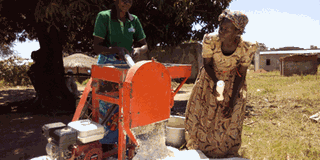New cassava varieties give hope to farmers

Women grate cassava before drying it at the farm. Photo by Peter Ewamu
What you need to know:
- Unlike the traditional varieties which take an average of 15 to 18 months to reach maturity, new varieties mature in nine months, writes SIMON PETER EMWAMU.
Although commercial cassava growing remains a singular venture many dread to undertake, those who have embraced it know the benefits are beyond the ordinary.
Away from cultivating it for home consumption, those who have discovered and invested in the new cassava varieties have made a fortune.
Oryem Can Widows and Orphan care Cassava Growers Association, is one such dedicated group eking a living through commercial cassava growing and value addition. The association in Bar Sub County, Lira District is composed of 74 widows, who have discovered a lifetime gem in the latest cassava varieties and are highly demanded by the confectionary industries.
The association that once depended on ordinary cassava for subsistence got their breakthrough in 2013 when they embraced the new varieties and embarked on value addition.
On a busy day, when they have to beat the deadlines for orders mostly from Britannia Allied Industries, the group that relies on two petrol powered engines to grate cassava tubers, process between two to four trucks of fresh cassava.
Betty Achan, the association’s chairperson, attributes the group’s success to hard work, sacrifice and determination of the members.
Takeoff
Achan, whose three roomed commercial house at Abolet Trading Centre was built using cassava proceeds, recounts their breakthrough as having been ignited by African Innovation Institute (AFRII), a nonprofit organisation with a bias in agricultural research.
“They bought us 75 bags of early and high yielding cassava variety, from which we managed to plant a sizable eight acres of cassava, which was our takeoff point,” she narrates.
Success
From the incentive that came in form of improved cassava cuttings, Achan says they have managed to grow their fields to 117 acres of cassava.
“This progress in production is steadily changing our welfare, through continued empowerment by AFRII, we are able to process and compete for fair prices,” she explains.
Processing
She says during the processing stages, precaution is undertaken to ensure the set standards.
According to her, hygiene must come first to meet quality of processed flour is not compromised.
“Every peeled tuber has to be thoroughly washed before it is processed. For those processing, they have to boil the water with salt before washing the fresh cassava,” she explains.
Drying
On a hot day, the grated cassava normally takes two hours to dry before milling.
“Drying the grated cassava must be done in accordance with the prescribed standards without compromising quality,” he says.
“After processing, every kilogramme of flour is bought at Shs1,600 at the Windwood Millers in Lira Town. This is good money because we deliver five to eight tonnes of flour,” Achan adds.
Profits
In total, Achan reveals they annually make more than Shs40m in cassava proceeds, which money tlent out to members at a low interest rate.
Through Operation Wealth Creation (OWC), she says they have been able to supply more than one million bags of cassava to the districts of Otuke, Amolatar, Kitgum and Oyam.
“Our bank account has been credited with Shs10m by the government that bought our cassava,” Achan says.
Achievements
Another such empowered widow, whose life been changed is Santa Akia, vice chairperson of the association. With money from the association, Akia has constructed herself a modest house.
Prospects
“We intend increase our production,” Akia says, adding that their target is to have more than 250 acres of improved cassava variety by close of 2018.
“In this quest, every member would be expected to have an additional three acres of cassava,” she adds.
She says the beauty about the improved cassava varieties is that they are early maturing, less tedious to weed, and resistant to pests and diseases.
On average, both the Nase variety and NaroCas one, take a period of nine months to be ready for processing and consumption, unlike the traditional varieties which take an average of 15 to 18 months.
Challenges
“The biggest problem here is transportation. We intend to buy a truck which will deliver our cassava and flour to the market,” Akia says.The women sometimes battle thieves who raid their gardens for food.




